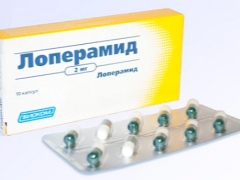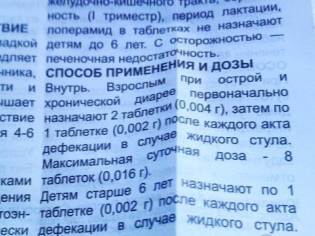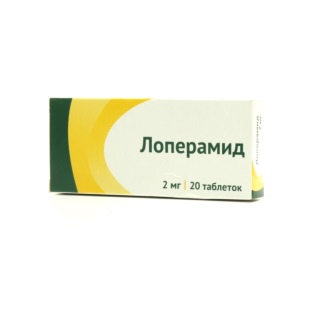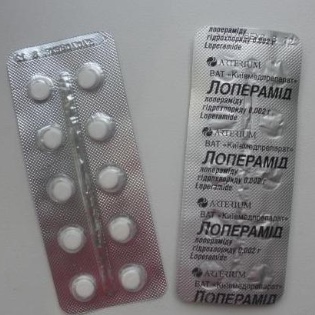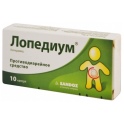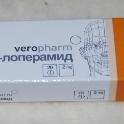Loperamide children
Digestive disorders in the form of loose stools are often found in children. They can be triggered by stress, changes in nutrition, allergies, chronic inflammation and other factors. In order to prevent dehydration, which in the body of children develops rather quickly, it is important to start giving rehydration solutions to the child from the very beginning of diarrhea and vomiting.
In some cases, it is also possible to resort to drugs for diarrhea, one of which is Loperamide. Is such a medicine used at an early age, at what dose and how its active substance acts on the child's body?
Release form
Loperamide is presented in two forms:
- Pills. They have a flat cylindrical shape, white-yellow or white color and there is a risk. Such tablets are sold either packaged in blisters of 10 pieces, or in glass jars. One box usually contains 10 or 20 tablets.
- Capsules They have a white-green gelatin shell and a white-yellow or white powder inside. One pack includes 10 or 20 capsules.
In the form of syrup, injection, suspension or other forms of such a drug is not made.
Composition
The active ingredient in each form of the drug is represented by loperamide hydrochloride. As in one tablet, and in one capsule, it is contained in the same dosage, which is 2 mg.
Among the excipients in the drug from different manufacturers can see Aerosil, potato starch, gelatin, lactose, polyvinylpyrrolidone, talc and other substances. If the child has intolerance to any components, their list should be clarified in the instructions for the selected Loperamide.
Operating principle
The active compound of capsules or tablets binds to receptors in the intestines, resulting in the motility and tone of smooth muscles in the intestinal walls are inhibited. Also, loperamide has the ability to inhibit the release of prostaglandins and other compounds, which also reduces peristalsis and prolongs the time it takes for food masses to pass through the intestines. In addition, the drug affects the anal sphincter, enhancing its tone and retaining the fecal mass in the intestinal lumen.
The antidiarrheal effect of the drug begins to appear after taking it quickly enough and lasts up to 4-6 hours. Metabolic changes of the drug occur in the liver, so when violations of the function of this body, the risk of side effects of Loperamide increases. The drug is withdrawn, mainly with bile, which enters the feces.
Indications
The drug is used for diarrhea caused by different reasons:
- The change in diet.
- Emotional stress.
- Medication.
- Traveling
- Allergic colitis or gastroenteritis.
- Functional digestive disorders.
- Radiation therapy.
- Disorders of metabolic processes.
In addition, Loperamide is required in the presence of ileostomy.
At what age is it allowed to take?
The use of loperamide in children is limited because they are more sensitive to the effect of this drug on the smooth muscles of the intestines and on the central nervous system. At the age of up to one year, the drug often provokes paralysis of the muscles of the intestines, which can even be fatal.
At the age of 12 years, the drug is taken only as prescribed by a doctor. Children under 6 years old are not usually prescribed the drug, and babies under 2 years of age are strictly contraindicated.If the treatment of diarrhea requires infants or preschoolers, then this child is prescribed other medications permitted for his age group.
Contraindications
Loperamide is not used:
- When hypersensitivity to its components.
- With diverticulosis.
- With pseudomembranous colitis provoked by antibiotic treatment.
- With intestinal obstruction.
- In acute dysentery and other intestinal infections. The drug can be administered in such diseases, but only in combination with other drugs.
If a child has severe liver disease, the question of using the medicine is decided by the doctor individually.
Side effects
Taking Loperamide may cause bloating, discomfort in the abdomen, constipation or intestinal colic. In some patients, the drug causes a feeling of dry mouth, dizziness, nausea, an allergic rash. Occasionally, the drug provokes drowsiness, fatigue, vomiting, urinary retention.
Instructions for use and dosage
- A child older than six years after each episode of bowel movement (if the stool is liquid) is given 2 mg, that is, one capsule or one loperamide tablet. The drug must be swallowed, washed down with water in a small volume.
- Maximum allowable dose medication per day for children is 6 mg, which corresponds to three capsules or three tablets.
- Additionally a child with diarrhea must get water and electrolytes to make up for their losses. In addition, you should follow a certain diet.
- Usually the medicine is prescribed. only for one or two days (less often - up to 5 days). If 48 hours after the first use of the drug, no improvement is noted, you should stop taking Loperamide and consult a doctor.
- As soon as the stool returned to normal or was absent for the last 12 hours, drug treatment is terminated.
Overdose
If you accidentally exceed the dose prescribed by the doctor Loperamide, this will lead to depression of the central nervous system, which will manifest itself with stupor, drowsiness, increased muscle tone, impaired coordination of movements and other symptoms. In addition, overdose can cause intestinal obstruction.
Having found the excess dose of medication, you should immediately show the child to the doctor. Depending on his condition, a small patient will have a gastric lavage and prescribe the necessary treatment, for example, the introduction of an antidote (this means naloxone).
Terms of sale
Loperamide belongs to OTC drugs, so it can be freely purchased at any pharmacy, but before treating a child, you must first consult with your doctor.
The drug costs not much - you need to pay about 8-12 rubles for the packaging of tablets, and a pack of capsules costs an average of 20-25 rubles.
Storage conditions
The instruction recommends keeping the capsules / tablets at home in a dry place where the air temperature will not exceed +25 degrees. Such a place should also be hidden from children.
Shelf life of the drug varies from different manufacturers and is 2, 3 or 4 years. It certainly should be checked on the box when buying to prevent the use of an expired drug in a child.
Reviews
There are many positive reviews about the use of Loperamide in children, in which moms say: pills or capsules really effectively eliminate diarrhea due to nervous experiences, overeating at a holiday, trying new products on a trip, and other reasons.
Many parents choose this medicine instead of more expensive counterparts, since Loperamide is cheap and available in most pharmacies. The main disadvantage of the drug is its frequent side effect on the children's body, for example, the appearance of abdominal pain, drowsiness or nausea.
You will learn more about using Loperamide for children in the following video.
Analogs
Other medicines with the same active ingredient can replace loperamide, for example:
- Imodium.
- Loperamide Akrikhin.
- Vero-Loperamide.
- Loperamide STADA.
- Lopedium.
- Diar.
- Superlop
They are all available in solid form (capsules / tablets) and are used in the same situations when Loperamide is prescribed. In addition to such means, a doctor with diarrhea, the doctor may recommend Smektu, Enterol, Bifiform, Diosmektit, Probifor and other drugs with antidiarrheal action. However, they include other active substances and have their own contraindications, so it’s not worth giving them without consulting the doctor (especially to young children).
